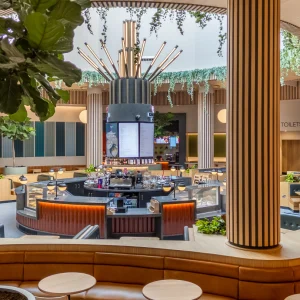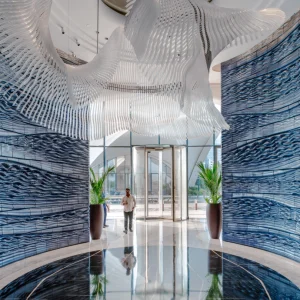Can you pinpoint the thought, whether yours or someone else’s, that led you to a career in design?
When I was 14, spending an exchange summer in France, my host family decided to bring me to an old cathedral. I was blown away by the experience – the smell, the sound quality, the light, the sense of compression and release of space. At that moment, I was given the sense that the design of space can create emotional responses – and that that was an experience that could be manipulated and managed, just like music, literature or art.
In terms of the design and architecture industry, what do you consider the most radical era or pivotal moment?
With the advent of modernism, we decided to abandon the fetishisation of the ancient, classical world. We had previously used classical vernacular as a sort of adornment while ignoring the structural and tectonic principles of the Greeks and Romans. In shifting to a more pure expression of structure, modernism embraced medieval Gothic principles instead, representing a shift in historical thinking.
 Bilbao’s Guggenheim. Image Credit: Karol Kozlowski/ www.Shutterstock.Com
Bilbao’s Guggenheim. Image Credit: Karol Kozlowski/ www.Shutterstock.Com
Which radical thinkers have been inspirations to you in your career?
Nathan Myhrvold is an amazing thinker. He is the epitome of the modern polymath. He is a legendary software engineer, a barbecue champion, a celebrated chef, the inventor of an anti-mosquito laser, and the finder of the most T-Rex fossils in history. He is a testament to the idea that clear, objective thinking can be applied to problem-solving in any field
Who outside the industry can architects and designers learn from?
The best design is able to identify a problem and then find a perfect solution for it.
Top-end architectural educations tend to focus on following a logical process to drive design solutions. Fields that similarly apply rigour and logic to problem-solving, like engineering, aerospace or the space industry, are great at embodying this sort of process.
What will lead the way for more radical thinking in your/our field?
Architects are currently terrified of AI. They feel that it will soon replace their jobs. But practitioners who learn how best to efficiently harness its possibilities will likely come to dominate the field.
 James Ramsey
James Ramsey
Could you recommend a book/article/blog that inspired your thinking?
PBS Space Time is a fantastic learning tool that explains how the universe works while also managing to capture a sense of wonder at how vast the universe is. Having a sense of awe inspires our curiosity and our sense of excitement in how to communicate ideas to others via design.
Could you name two buildings/pieces of furniture that you consider radical designs of their time, or perhaps still to this day?
The Guggenheim in Bilbao isn’t my favourite design, but it represents a fusion of digital modelling technologies and fabrication that was radical for its time.
Similarly, the way in which masons were able to model out the physics of the pointed arch, the buttress, and the three-part elevation, in late medieval Norman cathedrals, was a radical departure from previous Romanesque architecture. Instead of mimicking previous forms, Gothic masonry represented a form of problem-solving, prioritising structural efficiency to increase volume and light.
I think best with… (e.g. my hands/a pencil/ with a computer)
A cheap, yellow mechanical pencil.
 Ramsey says he thinks best while dreaming, and says that if he goes to sleep thinking about something, he gets to walk/ fly around spaces to envision design ideas. Image Credit: Metamorworks/ www.Shutterstock.Com
Ramsey says he thinks best while dreaming, and says that if he goes to sleep thinking about something, he gets to walk/ fly around spaces to envision design ideas. Image Credit: Metamorworks/ www.Shutterstock.Com
I think best… (e.g. first thing in the morning/ last thing at night)
While I’m dreaming. If I go to sleep thinking about something, I get to walk/fly around spaces to envision design ideas.
I think best when… (e.g. in a gallery/at home/outside/over drinks/with friends/ on the bus)
I’m sketching, or when I’m bored…
The thought that keeps me up at night is…
Ha! Meeting payroll for my staff every two weeks…
The thought that gets me out of bed each day is…
I recently got married, and my wife has a crazy, fancy La Marzocco espresso machine. It makes incredible coffee, but it makes terrible coffee if you don’t know what you’re doing. Anyway, I start obsessing about it about an hour before I actually wake up.
Do you like to think with, or think against?
Against. I think we often rely on the momentum of what folks have been doing before us, but virtually everything in the world can be rethought, and usually for the better!
If you weren’t a designer/architect, where do you think your way of thinking would have led you?
I have a lot of interests, from history to palaeontology and archeology, to guitar, to origami, to physics. I think the thing that most intrigues me is space exploration, and I probably would be in that field had I not decided to go into design.
 Architects and designers can learn from fields that apply rigour and logic to problem-solving, like engineering, aerospace or the space industry, according to Ramsey. Image Credit: Kalashnyk/ www.Shutterstock.Com
Architects and designers can learn from fields that apply rigour and logic to problem-solving, like engineering, aerospace or the space industry, according to Ramsey. Image Credit: Kalashnyk/ www.Shutterstock.Com
Could you describe radical thinking in three words?
Rethink it all.
What’s the most radical thing you’ve come across today or this week?
My mother-in-law is going through radiation for cancer, and what I realised is that it works by the same principle as Nathan Myhrvold’s mosquito laser: three beams triangulate in three dimensions, in order to burn where the beams all meet in precise space.





